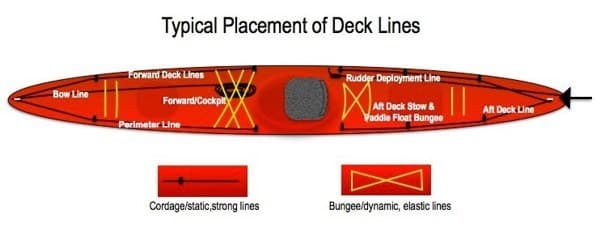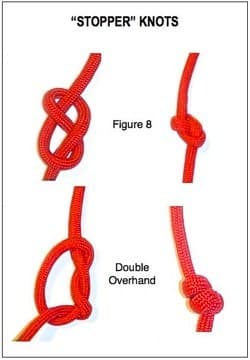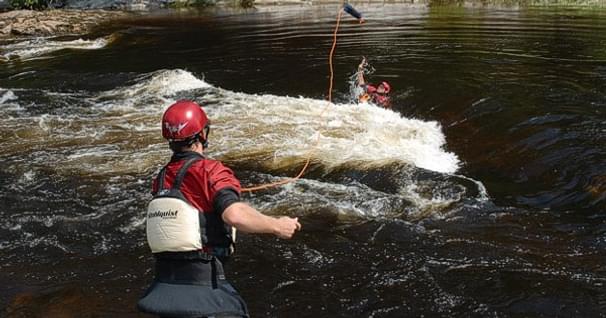Deck Lines & Rigging
By the most basic definition, any form of rope or cordage on a vessel is referred to as a "line". Prefaced with "deck", the terms "deckline" or "deck lines" are common phrases used throughout the paddling world.
While lines on canoes are primarily those used for anchors or bow lines, the deck of most kayaks is a webwork of elastic and static cordage of varying lengths and connections - all arranged in a network of utility to provide grab-holds, secure gear to the deck, tether hatches (and sometimes paddles), operate rudders and so forth.
Stowing gear on deck is a debatable issue among paddlers. Some will argue that careful placement, properly trimmed items atop you deck is a necessary method for hauling large amounts of gear on extended trips. Others will suggest better assessment of gear needs and warn of the disadvantages of a top-heavy, wind-catching load. For smaller, quick-to-get-to items, however, being snuggly secure within arm's reach on the deck of a kayak works for most paddlers.
Here are the basic functions of different types of deck line configurations:

- Perimeter Deck Line A line running along the outer edge of the deck, secured snuggly to the deck but loose enough to reach under and hook with one's fingers. Useful for grabbing on anywhere along the boat and holding on to the kayak in a capsize or rescue situation.
- On-deck gear stowage Typically an "X" or "II" pattern of bungee cords aligned parallel to the forward cockpit rim or seating area. Useful for easily accessible stowing of water bottles, small gear pouches and other items within reach for intermittent retrieval.
- Spare Gear Access Lines Installed to let you carry specific pieces of gear such as a breakdown spare paddle on deck (either fore or aft), paddle float, etc.
- Bow Line Attached to the bow for mooring, or otherwise securing the kayak via a lead line off the bow. I've tied a bowline knot at the end of my bow line so I have a ready-made loop for my immediate use.
- Rudder Line Section of line that enables paddler to raise/lower rudder from cockpit area.
- Paddle Float/Gear Stow Usually the "X" pattern right behind the cockpit used as a means to secure a paddle blade during a paddle float rescue. It also serves as another deck-top stow area for small, miscellaneous items.
- Hatch Cover Tether A short leash-like section of line that tethers the hatch cover to the kayak and prevents it from being lost when removed from hatch rim.
- Other lines When fishing, some paddlers like to use an anchor to keep their kayaks from drifting. There are several ways to secure an anchor line to a kayak, either using special anchor line clam-cleats or via a reinforced deck loop, other similar clips or a quick-release knot! The anchor and coiled line can be stowed under the forward deck (bungee) lines on the kayak.
TAHE 10'6 & 11'6 SUP-YAK Inflatables
2-in-1 Kayak & Paddle Board complete packages for single or tandem use.
Line Material and Sizes
Two types of cordage are used for deck lines: Static lines are stable; they provide firm, solid support and won't stretch. Perimeter deck lines, anchor lines, etc. would be considered static lines. Dynamic lines are elastic, they do stretch or give. Bungee cords are dynamic, stretching to hold gear in place like a rubber band. They each have their place of utility along the deck of a kayak.
Typically deck line cordage for kayaks come in two diameters: 4mm (~3/16) and 5mm (~1/4"). You can find nylon cordage to use as deck line at most hardware stores and it will probably work fine. Personally, I always try to buy cordage I am going to use in a marine environment from a marine supply outlet. Whether you are buying new cordage for deck lines or replacing old, frayed or otherwise weakened cordage, just make sure you go the quality route!
Special Uses / Perimeter Line:
Boats can be slippery, hands can be numb, the cockpit rim unreachabe - for whatever reason. Being able to grab anywhere along your kayak can be a critical move during a capsize or rescue. A solid grab line attached along the outside edge/perimeter of your kayak will provide you with a reliable emergency handhold/grab line along the entire length of your boat.
This line should be large enough to provide a solid finger hold without cutting into your hand. You fingers should be able to slip under the line yet it should also be secure enough on the deck so that it doesn't sag or otherwise form loops or catches that could entrap you as you scramble along or tumble over the deck during an exit or failed roll - whatever.
Usually the perimeter line is secured to the deck at intervals, either through recesses or extended deck loops through which the line has been fed - all the way around the boat, or in two large sections outlining the fore and aft sections beyond your cockpit. Many manufacturers will use reflective line (3M ScotchLite, for instance) that has thin strips of reflective material interwoven throughout the fibers to provide a modest but effective line of visibility (it glows when a distant light shines on it - helpful for being seen in the dark).


Special Uses / Deck Beads and Toggles:
Stowing gear on decks of kayaks was a vital factor for ancient paddlers who hunted and fished from their small crafts. Harpoon shafts and coiled lines, seal float bladders, atlatls and other implements had to be secured within easy reach by the paddler. Not only did the deck line have to hold the tool tightly, the paddler had to quickly stow one implement to retrieve another.
To be effective, a deck line had to hold the gear securely - it had to be tight against the deck. That creates a problem - by being so taunt it is hard to catch the line in order to pry it up to fit and pass the tip or edge of an implement under for secure stowage.
Natives used toggles (elongated pieces of wood or bone with a hole drilled through its side) that were threaded in along static deck lines. The toggle raised the line slightly above the surface of the deck. This allowed the line to remain taunt while creating a space between the deck and the line. Sometimes a bone bead was fed along the line to create this gap. A technique based on that same deck bead principle involves tying a large knot (an in-line stopper knot- see below) that effectively creates a raised gap in the line.
Special Uses / Bungee cords:
Elastic bungee cords perform a variety of tasks throughout a kayak, stem to stern, interior and exterior. Any time a secure but flexible grab is needed, a bungee cord usually comes to the rescue.
Most kayaks offer the conventional "X" or "XX" pattern on the foredeck. Another popular arrangement is the 'II" or "III" alignment. The size of the bungee and the width of the X or spacing between the II seems to be the limiting factor on which one works best.
The "X" configuration behind the cockpit is used for securing a paddle in a paddle float rescue. Sometimes the "X" is strengthened by adding a bungee segment across the top and bottom of the "X" as well - and often doubled to provide a better hold as stress is put on the paddle.
Stopper Knots:
Oftentimes the end of a line is threaded through a loop to secure/anchor one end of a network. That line can be tied or enlarged so it won't slip back through the opening in the loop or clip or even slip out of the knot tied to hold it all together. A stopper knot is simply a knot tied to the end of a line to prevent that end from slipping back through a bend in the line or other opening. They are especially effective in securing both ends of a bungee configuration as you can stretch the end, tie the knot and let go - the tension and the knot work together to make it a secure, clean fit.

Two common stopper knots are the double overhand and the figure-8. The former is simply a regular overhand knot with an extra turn through the loop before closing it together. The figure-8 is basically a crossover overhand that looks like an "8" when tied properly. Both create an enlarged knot at the end of the rope preventing slippage back through the opening.
These two knots can also be used in line to raise the tight line up off the deck enough to create a gap for the tip of a gear item or you finger to catch so it can be slid under the deck line.
Securing lines
Lines are guided along decks using recessed deck fittings or inserts. There are also many different deck clips (stainless steel, molded poly' or nylon) that help re-direct lines across the decks or gather/disperse lines as needed around/to other deck fittings and features. (See my "Clips, Clamps and Cleats" article for more about deck hardware). You can easily create your own array of deck lines by installing addition clips and loops yourself. It's important to use stiffeners and water sealants when applying to the thin deck of a kayak.
The most important thing to remember about deck lines is that they should never compromise the safe use of your kayak. No interaction with any line or clip - whether from being entangled on sagging loops on the outside to being caught on excessively long bolt/nut stems protruding under the deck or loose rudder/foot brace cords inside your cockpit - should jeopardize a quick exit when necessary.
Check your deck lines periodically and replace them with the appropriate size and "action" you will need. Remember, too, that bungees are great for securing loads quickly but do have weight-bearing limitations. Static lines are stronger but require a good knot or fastening system to remain firm.
Don't forget to include a few lengths of dynamic and static cordage in your repair kit, along with spare deck hardware and the tools to make any emergency repairs or replacements while out paddling.
Be Safe, Have fun out there!
Tom Watson is an avid sea kayaker and freelance writer. For more of Tom's paddling tips and gear reviews go to his website: www.wavetameradventures.comHe has written 2 books, "Kids Gone Paddlin" and "How to Think Like A Survivor"that are available on Amazon.com.
Related Articles
Casting out a rescue throw line, either contained within a Throw Bag or gathered in coils requires…
One of the most critical, and versatile pieces of kayaking gear is a workable length of line. Most…
One of the lowest-risk and most effective techniques for reaching a victim is by use of a throw rope. In…
Picture yourself approaching a set of rapids, with only a faint out-of-the-way animal trail heading up a…




